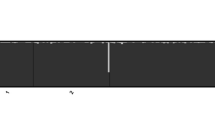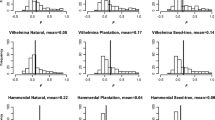Genetic changes following domestication of Douglas-fir were studied using isozyme data derived from two generations of seed orchards and their 49 wild progenitor populations. In addition, the breeding, production, and infusion populations used in the seed orchards were compared to their wild counterparts. Several parameters of gene diversity were measured (number of alleles per locus N a, per cent of polymorphic loci PLP, and expected heterozygosity H, and population divergence D). These measures were similar or higher in the domesticated populations compared to their natural progenitors, indicating that early selection and breeding of a highly polymorphic species does not significantly reduce genetic variation. The two generations of seed orchards also did not differ, indicating that genetic variation may remain stable over future generations of forest plantations. Interestingly, compared to the natural populations, heterozygosity was higher in the seed orchards, probably due to pooling of widely distributed natural populations; however, rare localized or private alleles seemed to be less frequent in the domesticated populations. Differentiation values were not significant between the first generation orchards and the natural populations, but significant differences were observed between the second generation orchards and the wild progenitor populations, probably due to the interbreeding that forms the advanced generation seed orchards.
Similar content being viewed by others
References
Aspit V.J., Nakamura R.R. and Wheeler N.C. (1989) Differential male reproductive success in Douglas-fir. Theor. Appl. Genet. 77, 681–4.
Bergmann F. and Ruetz W. (1991) Isozyme genetic variation and heterozygosity in random tree samples and selected orchard clones from the same Norway spruce populations. For. Ecol. Manage. 46, 39–47.
Brown A.H.D. (1978) Isozymes, plant population genetic structure and genetic conservation. Theor. Appl. Genet. 52, 145–57.
Brown A.H.D. and Clegg M.T. (1983) Isozyme assessment of plant genetic resources. In Isozymes: Current Topics in Biology and Medical Research, Vol. II (M.C. Rattazzi, J.G. Scandalios and G.S. Whitt, eds.) pp. 285–95. New York: Alan R. Liss.
Brunel D. and Rodolphe F. (1985) Genetic neighbourhood structure in a population of Picea abies L. Theor. Appl. Genet. 71, 101–10.
Burdon R.D. (1988) Recruitment for breeding populations: objectives, genetics, and implementation. In Proc. of the 2nd Inter. Conf. on quantitative genetics (B.S. Weir, E.J. Eisen, M.M. Goodman and G. Namkoong, eds) pp. 555–72. Sunderland, MA: Sinauer Associates Inc. Publishers.
Chaisurisri K. and El-Kassaby Y.A. (1994) Genetic diversity in a seed production population vs natural populations of Sitka spruce. Biodiv. Conserv. 3, 512–23.
Copes D.L. and Sniezko R.A. (1991) The influence of floral bud phenology on the potential mating system of a wind-pollinated Douglas-fir orchard. Can. J. For. Res. 21, 813–20.
Cathbert J.R. (1992) Forest renewal: the foundation for enhanced forest stewardship. In The Silviculture Conference: Stewardship in the New Forest (C. Boisvert and L. Grant, Chair and Coordinator) pp. 306–11. Ontario: Forestry Canada, Ottawa.
El-Kassaby Y.A. (1991) Genetic variation within and among conifer populations: review and evaluation of methods. In Biochemical markers in population genetics of forest trees (H.H. Hattemer, S. Fineschi, F. Cannata and M.E. Malvolti, eds) pp. 59–74. The Hague. SPB Academic Publishing bv.
El-Kassaby Y.A. and Askew G.R. (1991) The relation between reproductive phenology and output in determining the gametic pool profile in a Douglas-fir seed orchard. For. Sci. 37, 827–35.
El-Kassaby Y.A. and Cook C. (1994) Female reproductive energy and reproductive success in a Douglas-fir seed orchard and its impact on genetic diversity. Silvae Genet. 43, 243–6.
El-Kassaby Y.A. and Davidson R. (1991) Impact of pollination environment manipulation on the apparent outcrossing rate in a Douglas-fir seed orchard. Heredity 66, 55–9.
El-Kassaby Y.A. and Namkoong G. (1994) Impact of forest management practices on genetic diversity and its conservation. In Proc. International Symposium on Genetic Conservation and Production of Tropical Forest Tree Seed (R.M. Drysdale, S.E.T. John and A.C. Yapa, eds) pp. 205–13. Saraburi, Thailand: ASEAN-CANADA Forest Tree Seed Centre Project, Muak-Lek.
El-Kassaby Y.A. and Ritland K. (1992) Frequency-dependent male reproductive success in a polycross of Douglas-fir. Theor. Appl. Genet. 83, 752–8.
El-Kassaby Y.A. and Ritland K. (1996) Genetic variation in low elevation Douglas-fir of British Columbia and its relevance to gene conservation. Biodiv. Conserv. 6, 779–794.
El-Kassaby Y.A. and Sziklai O. (1982) Genetic variation of allozyme and quantitative traits in a selected Douglas-fir [Pseudotsuga menziesii var. menziesii (Mirb.) Franco] population. For. Ecol. Manage. 4, 115–26.
El-Kassaby Y.A., Yeh F.C. and Sziklai O. (1981) Estimation of the outcrossing rate of Douglas-fir [Pseudotsuga menziesii (Mirb.) Franco] using allozyme polymorphism. Silvae Genet. 30, 182–4.
El-Kassaby Y.A., Meagher M.D., Parkinson J. and Portlock F.T. (1987) Allozyme inheritance, heterozygosity and outcrossing rate among Pinus monticola near ladysmith, British Columbia. Heredity 58, 173–81.
El-Kassaby Y.A., Ritland K., Fashler A.M.K. and Devitt W.J.B. (1988) The role of reproductive phenology upon the mating structure of a Douglas-fir seed orchard. Silvae Genet. 37, 76–82.
El-Kassaby Y.A., Fashler A.M.K. and Crown M. (1989) Variation in fruitfulness in a Douglas-fir seed orchard and its effect on crop management decisions. Silvae Genet. 38, 113–21.
El-Kassaby, Y.A., Barker, J.E. and Dunsworth, B.G. (1994) Conservation of forest genetic resources — British Columbia's coastal industry perspectives. In Conservation of Forest Genetic Resources Workshop, November 1993. Toronto: in press.
Ellstrand N.C. and Marshall D.L. (1985) The impacts of domestication on distribution of allozyme variation within and among cultivars of radish, Raphanus sativus L. Theor. Appl. Genet. 69, 393–8.
Erickson V.J. and Adams T.W. (1989) Mating success in a coastal Douglas-fir seed orchard as affected by distance and floral phenology. Can. J. For. Res. 19, 1248–55.
Francis C.A. (1981) Development of plant genotypes for multiple cropping systems. In Plant Breeding II (K.J. Frey, ed.) pp. 179–231. Ames: The Iowa State University Press.
Hamrick J.L., Godt M.J.W. and Sherman-Broyles S.L. (1992) Factors influencing levels of genetic diversity in woody plant species. New For. 6, 95–124.
Heaman, J.C. (1985) A breeding program in the coastal Douglas-fir (Pseudotsuga menziesii (Mirb.) Franco). In Proc. 18th Can. Tree Improv. Assoc. Part I (C.W. Yeatman and T.J.B. Boyle, eds.) pp. 186–8.
Levin D.A. (1976) Consequences of long-term artificial selection, inbreeding and isolation in Phlox. 2. The organization of allozymic variability. Evolution 30, 463–72.
Li P. and Adams W.T. (1989) Range-wide patterns of allozyme variation in Douglas-fir (Pseudotsuga menziesii). Can. J. For. Res. 19, 149–61.
Markel S.A. and Adams W.T. (1987) Patterns of allozyme variation within and among Douglas-fir breeding zones in southwest Oregon. Can. J. For. Res. 17, 402–7.
Marshall D.R. and Brown A.H.D. (1975) Optimum sampling strategies in genetic conservation. In Crop genetic resources for today and tomorrow (O.H. Frankel and J.G. Hawkes, eds) pp. 53–80. London: Cambridge University Press.
Millar C.I. and Marshall K.A. (1991) Allozyme variation of Port-Orford-cedar (Chamaecyparis lawsoniana): implications for genetic conservation. For. Sci. 37, 1060–77.
Moran G.F. and Adams W.T. (1989) Microgeographical patterns of allozyme differentiation in Douglas-fir from southwest Oregon. For. Sci. 35, 3–15.
Mouna O. (1989) Population genetics in forest tree improvement. In Plant population genetics, breeding and genetic resources (A.H.D. Brown, M.T. Clegg, A.L. Kahler and B.S. Weir, eds) pp. 282–98. Sunderland, MA: Sinauer Associates Inc. Publishers.
Müller-Starck G. (1987) Genetic differentiation among seed samples from provenances of Pinus sylvestris. Silvae Genet. 36, 232–8.
Nakamura R.R. and Wheeler N.C. (1992) Pollen competition and parental success in Douglas-fir. Evolution 46, 846–51.
Namkoong, G. (1994) Genetic diversity for forest policy and management. In Measuring biodiversity for forest policy and management workshop. Feb., 1994, Vancouver: in press.
Neale D.B. and Adams W.T. (1985) The mating system in natural and shelterwood stands of Douglas-fir. Theor. Appl. Genet. 71, 201–7.
Nei M. (1973) Analysis of gene diversity in subdivided populations. Proc. Natl. Acad. Sci. USA 70. 3321–3.
Nei M. and Roychoudhury A.K. (1974) Sampling variances of heterozygosity and genetic distance. Genetics, 76, 379–90.
Reynolds S. and El-Kassaby Y.A. (1990) Parental balance in a Douglas-fir seed orchard: cone vs seed production. Silvae Genet. 39, 40–2.
Ritland K. and El-Kassaby Y.A. (1985) The nature of inbreeding in a seed orchard of Douglas-fir as shown by an efficient multilocus model. Theor. Appl. Genet. 71, 375–84.
Roberds J.H., Friedman S.T. and El-Kassaby Y.A. (1991) Effective number of pollen parents in clonal seed orchards. Theor. Appl. Genet. 82, 313–20.
Savolainen O. and Karkkainen K. (1992) Effect of forest management on gene pools. New For. 6. 329–45.
Savolainen O. and Yazdani R. (1991) Genetic comparison of natural and artificial populations of Pinus sylvestris. In Genetic Variation in European Populations of Forest Trees (G. Müller-Starck and M. Ziehe, eds) pp. 228–34. Frankfurt am Main: Sauerländer's Verlag.
Shaw D.V. and Allard R.W. (1982) Estimation of outcrossing rates in Douglas-fir using isozyme markers. Theor. Appl. Genet. 62, 113–20.
Wright S. (1965) The interpretation of population structure in F-statistics with special regard to systems of mating. Evolution 19, 395–420.
Yeh F.C. and O'Malley D.M. (1980) Enzyme variation in natural populations of Douglas-fir, Pseudotsuga menziesii (Mirb.) Franco, from British Columbia. I. genetic variation patterns in coastal populations. Silvae Genet. 29, 83–92.
Yeh F.C. and Morgan K. (1987) Mating system and multilocus associations in a natural population of Pseudotsuga menziesii (Mirb.) Franco. Theor. Appl. Genet. 73, 799–808.
Author information
Authors and Affiliations
Rights and permissions
About this article
Cite this article
El-Kassaby, Y.A., Ritland, K. Impact of selection and breeding on the genetic diversity in Douglas-fir. Biodivers Conserv 5, 795–813 (1996). https://doi.org/10.1007/BF00051787
Received:
Revised:
Issue Date:
DOI: https://doi.org/10.1007/BF00051787




